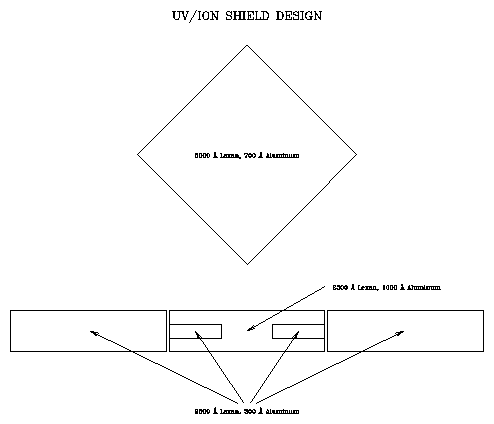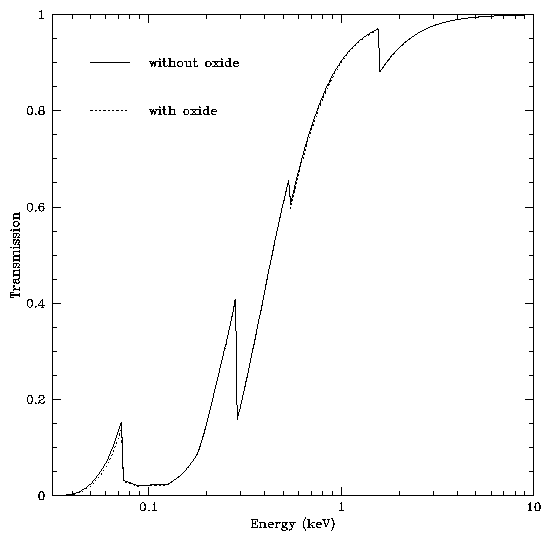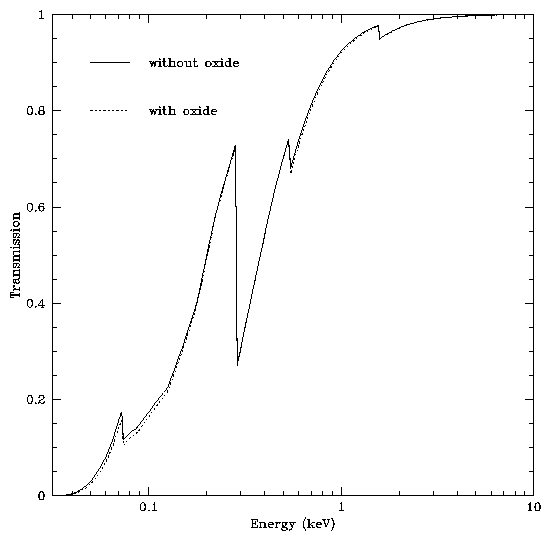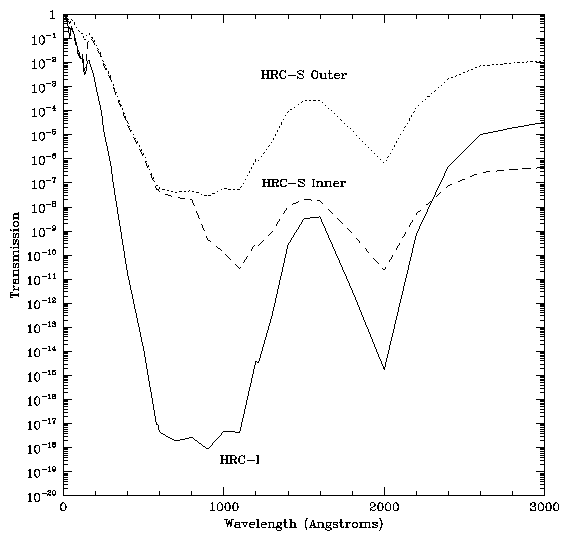
The detection efficiency of the HRC-I and HRC-S instruments is a combination of several effects. This is the first in a series of memos which breaks the description of the detection efficiency into distinct segments. A first cut at separation can be made at the UV/Ion Shield-microchannel plate (MCP) interface. This memo will describe the performance of the UV/Ion shield.
The UV/Ion Shield, as its name implies, blocks ultraviolet light and ions as well as low energy electrons from interacting with the MCPs, mimicking x-ray events. In the HRC, the UV/Ion Shield also acts as an additional electrode biased slightly positive with respect to the top of the MCP stack. This has the effect of sweeping electrons produced by x-ray interactions with the interchannel web, the area between the pores, away from the MCP.
There are actually four UV/Ion Shields in the HRC, one for the imaging detector and three for the spectroscopy detector. Each UV/Ion Shield consists of an aluminum coated thin plastic membrane. After evaluating several materials, the polycarbonate Lexan has been selected for the plastic. The thicknesses of the Lexan and aluminum are selected to provide high x-ray transmission while minimizing UV transmission. Three different combinations of thicknesses are used as shown in figure 1: one for the HRC-I, one for most of the inner segment of the HRC-S, and one for the outer segments of the HRC-S and the remainder of the inner.

Table 1 lists the baseline material thicknesses.
| Table 1 | ||
| Detector | Lexan (Å) | Aluminum (Å) |
| HRC-I | 6000 | 700 |
| HRC-S ``inner'' | 2500 | 1000 |
| HRC-S ``outer'' | 2500 | 300 |
The deposited aluminum will oxidize on exposure to air and as a result some unknown amount of the aluminum will be converted to aluminum oxide. An addition complication is that the morphology of this growth is unknown. The oxidation could occur preferentially along the boundaries of the aluminum grains leading to variable thicknesses of both the aluminum and the aluminum oxide on very small scales.
The x-ray transmission as a function of energy of one of the UV/Ion Shields can be calculated given the elemental composition of its constituents, the density and thickness of each, and the atomic mass absorption cross sections. Lexan has a chemical stoichiometry C16H14O3 and a density of 1.1 g cm-3. Bulk aluminum and aluminum oxide have densities of 2.7 g cm-3 and 3.6 g cm-3 respectively. Atomic mass absorption cross sections have been tabulated[1] and are accessible through the saolib routine rdacon and the script atcon.
Figure 2 is the x-ray transmission as a function of energy for the HRC-I UV/Ion Shield.

Two curves are plotted: one for the baseline filter and the other with some of the aluminum oxidized for a total of 50 Å of aluminum oxide (i.e 25 Å formed on each surface). The absolute difference between the two curves is energy dependent but small, reaching a maximum of about 0.007 just above the oxygen K-shell absorption edge. Figures 3 and 4 are similar to figure 2 but for the UV/Ion Shields over the inner and outer segments of the HRC-S respectively.


The absolute transmission differences between the cases with and without an oxide layer for the HRC-S UV/Ion Shields are larger than for the HRC-I rising to slightly greater than 1% for energies just above the oxygen K-shell absorption edge and for energies less than 0.1 keV. In practice the thicknesses for each of the materials will be determined by comparison of transmission measurements taken at several energies to models such as these.
Knowing the UV transmission of the UV/Ion Shield is one key to predicting the out of x-ray band response of the HRC. It is desirable to keep the contamination from UV flux during a given measurement as small as possible. Calculating UV transmission of the UV/Ion Shield is similar to calculating the x-ray transmission except that reflection by the UV/Ion Shield reduces its transmission in addition to absorption. Longward of 1200 Å the reflectivity is ² 90% which results in at least an order of magnitude reduction in transmission over a calculation considering only absorption. The reflectivity of the UV/Ion Shield can depend on details of the aluminum deposition process and the amount of oxidation making it difficult to model.
The absorption cross section of Lexan is no longer given by the cross sections of its constituent elements; the UV transmission of Lexan depends on chemical bonding. The HRC team has tabulations of Lexan linear attenuation coefficients from three sources (M. Barstow of the Univ. of Leicester, the U.C. Berkeley Space Sciences Lab., and Leiden) and have adopted those of Barstow based on agreement with their own laboratory transmission measurements. Figure 5 shows the expected transmission in the UV of all three UV/Ion Shields based only on absorption by the filter.

Because the reduction in transmission due to reflection was ignored these are conservative estimates of the transmission.
The extremely small transmission of the UV/Ion Shields in the 1000-3000 Å range poses a challenging calibration problem. The large dynamic range required to make measurements of transmissions in the range < 10-4 with decent signal to noise are not readily available with most detectors; calibrated neutral density filters must be used [2].
Dr. Michael Juda
Harvard-Smithsonian Center for Astrophysics
60 Garden Street, Mail Stop 70
Cambridge, MA 02138, USA
Ph.: (617) 495-7062
Fax: (617) 495-7356
E-mail: mjuda@cfa.harvard.edu